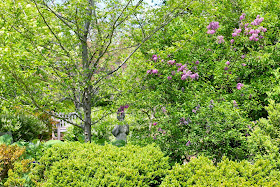In need of a break, I took the train to Washington, DC last week to visit some dear friends for a few days and relax. There were lots of fun activities including going out to Nationals Park to watch a live broadcast of the Washington National Opera Company's performance of Mozart's The Magic Flute. Earlier that day, we ventured over to Georgetown to check out Tudor Place, a historic home and garden.

In 1805, merchant Thomas Peter purchased 8½ acres of land in
Georgetown Heights for $8,000, money that his wife, Martha Parke Custis Peter, a
granddaughter of Martha Washington, had inherited from George Washington. Dr.
William Thornton was chosen to design a home for the Peters and their children
that would befit a family of their status. Utilizing some existing
buildings on the property as wings for a larger house, Thornton created a grand
building that mixed Federal and neoclassical design and included a
marble-floored Temple Portico. Finished in 1816 and named Tudor Place, it would
be home to six generations of the Peter family.

While I normally like visiting historic houses, we were interested in the garden.
When originally designed, the garden would have been used mainly to grow food and herbs for the family. Today, it’s purely ornamental with stone paths, a bowling green, small dell,
and the most wonderful sloping south lawn. I could only imagine how delightful it would be for a child to live here, able to play adventurer in the dell or roll down the lawn.
There were some flowers in bloom but not as many as I would have wished to have seen (a lone tulip told me I had missed my chance by a few weeks). Nonetheless, there were some pretty little roses to be found as well as massive peonies, hydrangeas, and bright pink azaleas.
The garden is broken up into different sections, which gives you the feeling of stepping from one land into another. While the dell is overgrown and filled with old growth trees (on one of which we spotted a black squirrel) other parts of the garden are very structured like the Flower Knot, in the center of which stands a sundial from Crossbasket Castle in Scotland, the Peter family's ancestral home. Speaking of the dell, there is a brick semicircular seat above it that's a great place to sit for a spell. Look closely at its wrought iron back, and you'll find the intertwined initials of the last owner of Tudor Place, Armistead Peter III, and his wife, Caroline.
One of the nicest surprises wasn't garden related at all. Rather it was Armistead Peter III's beloved 1919 Pierce Arrow roadster in the garage. Costing more than the original price of the property, it immediately conjured up images of flappers and Gatsby.
Sitting on a bench behind the house, listening to the birds in the trees, it was easy to see why Tudor Place stayed in the Peter family as long as it did. It's absolutely lovely.
Tudor Place is located on a street filled with loads of historic homes and so after the garden we went for a stroll. We walked by Dumbarton Oaks, which I've visited before to see their beautiful garden (this time we just stopped to admire their lush lilac hanging over a wall and the shiny "1920" lettering on the gate).
There were so many nice houses to see, some with small gardens of their own and others with interesting signage (delivery and service entrance this way) and even a friendly neighbourhood cat. It was a perfect way to spend a sunny afternoon in Washington, DC.
For more information about Tudor Place, visit here.
All photos by Michele.
































